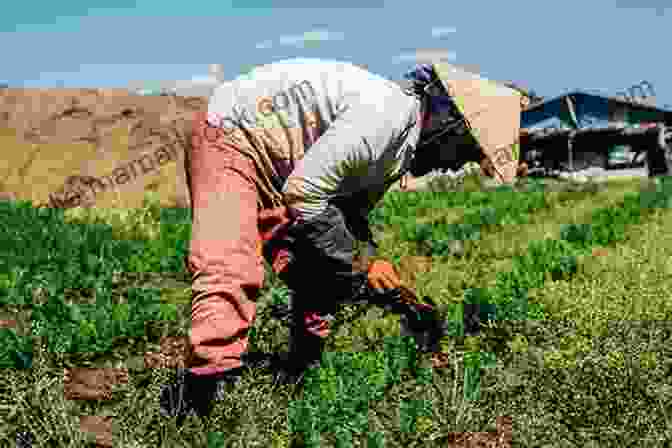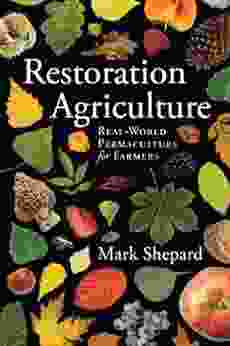Restoration Agriculture: Real-World Permaculture for Farmers


Restoration agriculture is a holistic approach to farming that focuses on restoring and maintaining the health of the soil and ecosystem. It is based on the principles of permaculture, which is a design system that seeks to create sustainable, resilient, and productive landscapes. Restoration agriculture practices can be applied to any type of farming, from small-scale vegetable gardens to large-scale commercial farms.
4.7 out of 5
| Language | : | English |
| File size | : | 12535 KB |
| Text-to-Speech | : | Enabled |
| Screen Reader | : | Supported |
| Enhanced typesetting | : | Enabled |
| Print length | : | 332 pages |
| Lending | : | Enabled |
Benefits of Restoration Agriculture
Restoration agriculture offers a number of benefits, including:
- Improved soil health: Restoration agriculture practices help to improve soil health by increasing organic matter, enhancing soil structure, and fostering microbial activity.
- Increased water retention: Restoration agriculture practices help to increase water retention in the soil, which makes crops more resilient to drought and flooding.
- Reduced erosion: Restoration agriculture practices help to reduce erosion by protecting the soil from wind and water damage.
- Increased biodiversity: Restoration agriculture practices help to increase biodiversity by creating habitats for a variety of plants and animals.
- Improved crop yields: Restoration agriculture practices can help to improve crop yields by providing plants with the nutrients and water they need to thrive.
Principles of Restoration Agriculture
The principles of restoration agriculture are based on the principles of permaculture. Permaculture is a design system that seeks to create sustainable, resilient, and productive landscapes. Permaculture principles can be applied to any type of land, from urban backyards to rural farms.
The following are some of the key principles of restoration agriculture:
- Work with nature: Restoration agriculture practices seek to work with nature, rather than against it. This means using natural processes to improve soil health, conserve water, and control pests and diseases.
- Close the loop: Restoration agriculture practices seek to close the loop between the farm and the environment. This means using on-farm resources to meet the needs of the farm, and recycling waste products back into the soil.
- Create diversity: Restoration agriculture practices seek to create diversity in the farm ecosystem. This means planting a variety of crops, raising different types of animals, and creating habitats for a variety of wildlife.
- Build resilience: Restoration agriculture practices seek to build resilience in the farm ecosystem. This means creating systems that are resistant to pests, diseases, and climate change.
Restoration Agriculture Practices
There are a number of different restoration agriculture practices that can be used to improve soil health, conserve water, and control pests and diseases. Some of the most common practices include:
- Cover cropping: Cover crops are plants that are grown to cover the soil and protect it from erosion. Cover crops can also help to improve soil health by adding organic matter and nutrients.
- Mulching: Mulch is a layer of organic matter that is spread over the soil to help retain moisture, suppress weeds, and improve soil health.
- Composting: Composting is the process of breaking down organic matter into a nutrient-rich soil amendment. Compost can be used to improve soil health and fertility.
- No-till farming: No-till farming is a soil management practice that reduces soil disturbance. No-till farming can help to improve soil health and water retention.
- Integrated pest management: Integrated pest management is a holistic approach to pest control that uses a variety of methods to prevent and control pests. Integrated pest management can help to reduce the need for pesticides.
Restoration agriculture is a holistic approach to farming that focuses on restoring and maintaining the health of the soil and ecosystem. Restoration agriculture practices can be applied to any type of farming, from small-scale vegetable gardens to large-scale commercial farms. Restoration agriculture offers a number of benefits, including improved soil health, increased water retention, reduced erosion, increased biodiversity, and improved crop yields.
If you are interested in learning more about restoration agriculture, there are a number of resources available online and in libraries. You can also find restoration agriculture workshops and training programs in many communities.
4.7 out of 5
| Language | : | English |
| File size | : | 12535 KB |
| Text-to-Speech | : | Enabled |
| Screen Reader | : | Supported |
| Enhanced typesetting | : | Enabled |
| Print length | : | 332 pages |
| Lending | : | Enabled |
Do you want to contribute by writing guest posts on this blog?
Please contact us and send us a resume of previous articles that you have written.
 Top Book
Top Book Novel
Novel Fiction
Fiction Nonfiction
Nonfiction Literature
Literature Paperback
Paperback Hardcover
Hardcover E-book
E-book Audiobook
Audiobook Bestseller
Bestseller Classic
Classic Mystery
Mystery Thriller
Thriller Romance
Romance Fantasy
Fantasy Science Fiction
Science Fiction Biography
Biography Memoir
Memoir Autobiography
Autobiography Poetry
Poetry Drama
Drama Historical Fiction
Historical Fiction Self-help
Self-help Young Adult
Young Adult Childrens Books
Childrens Books Graphic Novel
Graphic Novel Anthology
Anthology Series
Series Encyclopedia
Encyclopedia Reference
Reference Guidebook
Guidebook Textbook
Textbook Workbook
Workbook Journal
Journal Diary
Diary Manuscript
Manuscript Folio
Folio Pulp Fiction
Pulp Fiction Short Stories
Short Stories Fairy Tales
Fairy Tales Fables
Fables Mythology
Mythology Philosophy
Philosophy Religion
Religion Spirituality
Spirituality Essays
Essays Critique
Critique Commentary
Commentary Glossary
Glossary Bibliography
Bibliography Index
Index Table of Contents
Table of Contents Preface
Preface Introduction
Introduction Foreword
Foreword Afterword
Afterword Appendices
Appendices Annotations
Annotations Footnotes
Footnotes Epilogue
Epilogue Prologue
Prologue David S Brody
David S Brody John Kaufman
John Kaufman Jennifer Perkins
Jennifer Perkins V Balderston
V Balderston Kristen Stein
Kristen Stein George C Daughan
George C Daughan Marcello Sorce Keller
Marcello Sorce Keller Miranda Cowley Heller
Miranda Cowley Heller Kg Stiles
Kg Stiles Marisela Norte
Marisela Norte Dennis Charles
Dennis Charles Samuel Beckett
Samuel Beckett Kazuyuki Motohashi
Kazuyuki Motohashi Dan Abrams
Dan Abrams Laure Conan
Laure Conan Sara Bushway
Sara Bushway James Longford
James Longford Hunter Clarke Fields Msae
Hunter Clarke Fields Msae Nina Mingya Powles
Nina Mingya Powles Richard G Lewis
Richard G Lewis
Light bulbAdvertise smarter! Our strategic ad space ensures maximum exposure. Reserve your spot today!
 John GrishamFollow ·16.3k
John GrishamFollow ·16.3k Neil ParkerFollow ·17.1k
Neil ParkerFollow ·17.1k Francisco CoxFollow ·6.6k
Francisco CoxFollow ·6.6k Ian McEwanFollow ·4.6k
Ian McEwanFollow ·4.6k Steve CarterFollow ·10.6k
Steve CarterFollow ·10.6k Steven HayesFollow ·15.2k
Steven HayesFollow ·15.2k Jerome BlairFollow ·15.5k
Jerome BlairFollow ·15.5k Lawrence BellFollow ·14.9k
Lawrence BellFollow ·14.9k

 Dean Cox
Dean CoxHow to Make Decisions Easily & Effortlessly: The...
The Different Types of Decisions There...

 Gustavo Cox
Gustavo CoxThe End of World War II and the Birth of Baseball's...
The end of...

 Patrick Rothfuss
Patrick RothfussThe Dantes: An 11-Family Saga of Billionaires, Soulmates,...
The Dantes is an epic family saga that follows...

 Dylan Mitchell
Dylan MitchellSuper Friends: The Animated Adventures That Defined a...
In the vibrant landscape of American...

 Jamal Blair
Jamal BlairCollege For Students With Disabilities: We Do Belong
College can be a...
4.7 out of 5
| Language | : | English |
| File size | : | 12535 KB |
| Text-to-Speech | : | Enabled |
| Screen Reader | : | Supported |
| Enhanced typesetting | : | Enabled |
| Print length | : | 332 pages |
| Lending | : | Enabled |














